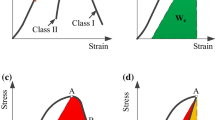Abstract
Active and passive ultrasonic methods were used to study the evolution of attenuation properties in a sample of Fontainebleau sandstone during true-triaxial deformation. A cubic sample of Fontainebleau sandstone (80 mm \(\times\) 80 mm \(\times\) 80 mm) was deformed under true-triaxial stresses until failure. From the stress state: \(\sigma _3 = 5\) MPa and \(\sigma _1 = \sigma _2 = 35\) MPa, \(\sigma _1\) was increased at a constant displacement rate until the specimen failed. Acoustic emission (AE) activity was monitored by 18 piezoelectric sensors and bandpass filtered between 100 kHz and 1 MHz. A source location analysis was performed on discrete AE data harvested from the continuous record where 48,502 events were locatable inside the sample volume. AE sensors were sequentially pulsed during periodic P-wave surveys among 135 raypaths. Analytical solutions for Biot, squirt flow, viscous shear, and scattering attenuation were used to discuss to observed attenuation at various stages of the experiment. We concluded that initial attenuation anisotropy was stress induced and resulted from friction and squirt flow. Later attenuation of the high-frequency spectrum was attributed to scattering as a result of the formation of large macroscopic vertical fractures. Passive (AE) ultrasonic data produced similar information to that from active data but with enhanced temporal and spacial resolution.













Similar content being viewed by others
Abbreviations
- \(\sigma _1\) :
-
Maximum principal stress (Pa)
- \(\sigma _2\) :
-
Intermediate principal stress (Pa)
- \(\sigma _3\) :
-
Minimum principal stress (Pa)
- \(\epsilon _1\) :
-
Strain in the \(\sigma _1\) direction (\(\%\))
- \(\epsilon _2\) :
-
Strain in the \(\sigma _2\) direction (\(\%\))
- \(\epsilon _3\) :
-
Strain in the \(\sigma _3\) direction (\(\%\))
- \(V_\mathrm{p}\) :
-
Ultrasonic P-wave velocity (m/s)
- \(V_\mathrm{s}\) :
-
Ultrasonic S-wave velocity (m/s)
- \(V_{\mathrm{p}1}\) :
-
Ultrasonic P-wave velocity in the \(\sigma _1\) direction (m/s)
- \(V_{\mathrm{p}2}\) :
-
Ultrasonic P-wave velocity in the \(\sigma _2\) direction (m/s)
- \(V_{\mathrm{p}3}\) :
-
Ultrasonic P-wave velocity in the \(\sigma _3\) direction (m/s)
- E :
-
Ultrasonic energy (J)
- J :
-
Energy flux (m\(^2\)/s)
- Q :
-
Attenuation quality factor
References
Biot MA (1956) Theory of propagation of elastic waves in a fluid saturated porous solid. II. Higher frequency range. J Acoust Soc Am 28:179–191
Biot MA (1962) Mechanics of deformation and acoustic propagation in porous media. J Appl Phys 33:1482–1498
Boatwright J, Fletcher J (1984) The partition of radiated energy between P and S waves. Bull Seismol Soc Am 74:361–376
Bourbie B, Zinszner B (1985) Hydraulic and acoustic properties as a function of porosity in Fontainebleau sandstone. J Geophys Res 90:11524–11532
Chow T, Martin CD, Young RP (2005) Assessing in situ microcrack damage using ultrasonic velocity tomography. Int J Rock Mech Min Sci 42:5–34
David EC, Zimmerman RW (2012) Pore structure model for elastic wave velocities in fluid-saturated sandstones. J Geophys Res 117:B07210
Gurevich B, Makarynska D, Bastos de Paula O, Pervukhina M (2010) A simple model for squirt-flow dispersion and attenuation in fluid-saturated granular rocks. Geophysics 75:109–120
Hudson JA (1981) Wave speeds and attenuation of elastic waves in material containing cracks. Geophys J R Astr Soc 64:133–150
Johnson DH, Toksoz MN (1980) Ultrasonic P and S wave attenuation in dry and saturated rocks under pressure. J Geophys Res 85:925–936
King MS, Shakeel A, Chaudhry NA (1997) Acoustic wave propagation and permeability in sandstones with systems of aligned cracks. Geol Soc Lond Spec Publ 122:69–85
King MS, Pettitt WS, Haycox JR, Young RP (2012) Acoustic emissions associated with the formation of fracture sets in sandstone and under polyaxial stress conditions. Geophys Prospect 60:93–102
Maugis D (1992) Stresses and displacements around cracks and elliptical cavities: exact solutions. Eng Frac Mech 43:217–255
Mavko G, Mukerji T, Dvorkin J (1998) The rock physics handbook: tools for seismic analysis in porous media. Cambridge University Press, Cambridge
McLaskey GC, Glaser SD (2012) Acoustic emission sensor calibration for absolute source measurements. J Nondest Eval 31:157–168
Nasseri MHB, Goodfellow SD, Lombos L, Young RP (2014) 3-D transport and acoustic properties of Fontainebleau sandstone during true-triaxial deformation experiments. Int J Rock Mech Min Sci 69:1–18
Pettitt WS (1998) Acoustic Emission Source Studies of Microcracking in Rock. Dissertation, Keele University, Keele
Reches Z, Dieterich JH (1983) Faulting of rocks in three-dimensional strain fields I. Failure of rocks in polyaxial, servo-control experiments. Tectonophysics 83:111–132
Sayers CM (1988) Stress-induced ultrasonic wave velocity anisotropy in fractured rock. Ultrasonics 26:311–317
Schubnel A, Thompson BD, Fortin J, Gueguen Y, Young RP (2007) Fluid-induced rupture experiment on Fontainebleau sandstone: premonitory activity, rupture propagation, and aftershocks. Geophys Res Lett 34:L19307
Snoke J (1987) Stable determination of (Brune) stress drops. Bull Seismol Soc Am 77:530–538
Stanchits SA, Lockner DA, Pnonmarev AV (2003) Anisotropic changes in P-wave velocity and attenuation during deformation and fluid infiltration of granite. Bull Seismol Soc Am 93:1803–1822
Walsh JB (1969) New analysis of attenuation in partially melted rock. J Geophys Res 74:4333–4337
Young RP, Hill JJ, Bryan R, Middleton R (1985) Seismic spectroscopy in fracture characterization. Q J Eng Geol Hydrogeol 18:459–479
Acknowledgments
The authors wish to thank Laszlo Lombos (formerly of ErgoTech Ltd.) and Applied Seismology Consultants for their technical support. The Itasca Education Partnership is acknowledged. In addition, we are grateful to Hamed Ghaffari for many useful discussions and input. The funding for the creation and operation of the Rock Fracture Dynamics Facility at the University of Toronto was provided by the Canada Foundation for Innovation and the Province of Ontario (Grant No. 0000302419) and the Natural Sciences and Engineering Research Council of Canada (Grant No. 0000300001), respectively.
Author information
Authors and Affiliations
Corresponding author
Rights and permissions
About this article
Cite this article
Goodfellow, S.D., Tisato, N., Ghofranitabari, M. et al. Attenuation Properties of Fontainebleau Sandstone During True-Triaxial Deformation using Active and Passive Ultrasonics. Rock Mech Rock Eng 48, 2551–2566 (2015). https://doi.org/10.1007/s00603-015-0833-8
Received:
Accepted:
Published:
Issue Date:
DOI: https://doi.org/10.1007/s00603-015-0833-8




